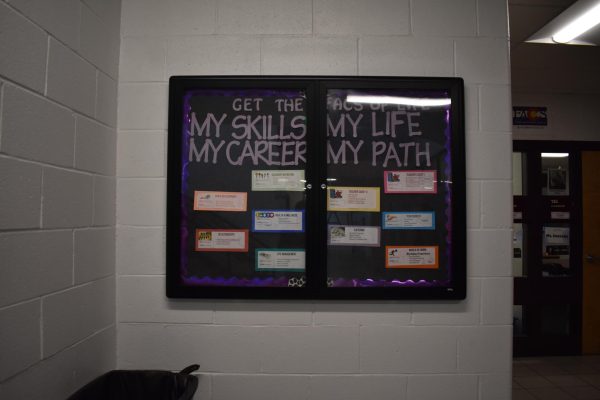
As stated in the Jefferson County graduation requirements, “One half credit in the fine arts defined as music, visual arts, or drama or in career and technical education is required [to graduate].”
Students can have at most 24 different electives through their Four years at Arvada West High School, but many end up with less than that, with 8 electives being the very minimum. With a huge range of how many electives a student can have, it questions whether the elective requirements are too much or too little.
Courtney Dalton, A-West’s Ceramics teacher, believes that the fine arts credits shouldn’t be grouped as they are, saying, “The thing that really gets me is like, right now you can take Spanish and that can count as your visual arts credit or your fine arts credit.” While all the elective options give plenty of choice for students to take classes they enjoy, it defeats the purpose of these credits being required; though some students may not particularly enjoy art classes, it’s hard to deny the benefits these courses can provide.
According to Dalton, “It makes you think in a different way, It makes you use the opposite side of your brain. It’s really good for problem-solving, and It’s really good for collaborative projects.” Art, though does not just help develop the brain and improve communication skills; it can also help with a person’s mental health by releasing dopamine.
The University of Victoria emphasizes the benefits, stating, “Seeing a completed work of art that you created stimulates the release of dopamine into our bodies which lowers feelings of depression an
d increases feelings of confidence.” While Art is very important and should be required, that doesn’t mean it s
hould overshadow the many other courses at A-West that can also help students and their futures. Classes like Teen Choices and Catering can also be very useful for students hoping to get more experience for future careers.
Anna Hirschauer, a teacher of both Teen Choices and Catering, agrees that these classes help prepare students for life saying, “We teach a lot of life skills like mental health and relationships. We teach in our culinary classes how to cook for yourself, how to measure, how to grocery shop,

and lots of great skills.” While art classes like Ceramics can help students become creative and make something that is their own, courses like Teen Choices and Catering can help students prepare for future jobs. With both of these electives being very important to help students develop, how does it make any sense that one could count as the other? Developing more elective requirements would ensure that students (whether they really enjoy the course or not) are still getting a meaningful experience and learning things that other courses may not teach. Adding more requirements like a ‘Life skills’ or ‘speech’ half credit would ensure that students are getting a full experience when it comes to all the electives here at A-West.
Lindsey Welsh, who teaches speech and debate along with theater, adds to this idea: “I know a lot of colleges require that ‘public speaking’ type of credit. I think that’s something that’s kind of fallen by the wayside a little bit.” Some kids may look over classes like Speech and Debate for their arts credit, either not realizing that it counts for the credit or not realizing how useful it could be for their future.
“I think the Fine Arts teach a lot of skills that are even more applicable in the workforce, like being creative, thinking on your feet, and being able to communicate. I think that stuff is really the highlight with the Fine Arts,” said Welsh. Gaining experience and learning how to be creative while doing so are just some of the benefits that classes falling under the fine arts credit can provide. With so many elective options, more graduation requirements would rarely make it harder on students who are still required to take electives most of their time at A-West regardless of the credits. The only question is, how many requirements are too many?
Considering only two elective requirements exist and they only require half-credits, adding two more requirements would mean a student could meet all those requirements over two semesters. Splitting electives into four required categories, including Physical Education/Health and Wellness, Fine/Performing Arts, Life Skills, and Spoken/Written Word would cover almost all electives and ensure that students are getting a well-rounded education through their electives. Adding more requirements would also help add even just a couple new electives so that there are more options for students to choose from for each requirement.
Hirschauer remembers an original version of Teen

Choices, saying, “They [would] learn how to make a budget, how to find an apartment, make a resume, and how to apply for a job.” Classes like these can help students prepare for what comes after high school; if there were to be more credit requirements, the school could create more classes to fill these categories and offer more useful courses to students.
According to K-12 Dive, around three-quarters of high school graduates said they were ‘moderately, slightly, or not at all’ prepared for making decisions about colleges or careers after high school. When looking at statistics like these, it’s important to remember that while there are lots of resources to help students with their futures, most tend to ignore them. And while courses that teach kids how to succeed in life are useful, many kids don’t find them fun or interesting, which results in these classes being ignored. Requiring these classes would make sure that students at least try them for a semester before moving on.
Some classes like high levels of Ceramics can even give students college credits; according to Dalton, “You can get college credits on the upper level or intermediate until the second semester and you can get up to 12 credits at Red Rocks.”
Under all these circumstances it would seem that adding two new credit requirements would ensure students are achieving a well-rounded high school experience while learning new things and preparing for their futures.


